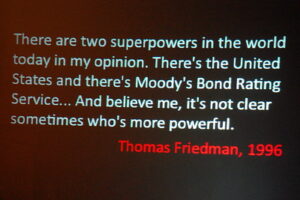Keeping tuition and fees low has taken on a new importance. With interest rates rising steadily, students who borrow to finance their educations (or to finance other costs associated with going to school) will be paying more each month.
The current student loan interest rate is 4.99%, which is pretty good. But that’s 1.26% higher than it was in 2021. The Department of Education determines federal student loan interest rates by taking the high-yield results of a 10-year Treasury note auction and applying an add-on to it. Usually, this process takes place in May of any given year. We will not know what the interest rates on federal student loans will be for the 2023-24 school year until then.
Even if the rate jumped another 1.26% next year, the student loan interest rate would be 6.25%. You might think that’s still not bad. That would make student loan interest rates very similar to mortgage interest rates, which are higher than they have been since 2006.
Here’s something you might not realize. One in five students uses a credit card to finance their educational costs. Currently, credit card interest rates are – on average – about 19.25%. And that’s for people with good credit. If a person slips into default by missing a payment, the interest rate could rise to 30% or more.
What is the likelihood of a student missing a credit card payment?
Raising tuition and fees to pay for construction costs, neglected maintenance, and shoring up the general fund places a real burden on students. WCC Trustees are so certain students can afford to pay more that they think nothing of larding on a brand new $5 per credit hour fee. For full-time students who pay their accounts with a credit card, that $75-per-semester fee might create an insurmountable debt.
Raising tuition and fees should be a last resort
The Trustees should not approve increases in tuition and fees until the administration can prove that it has no other alternative source of funding. For example, in 2021 WCC reported to the federal government that students had enrolled in 227,755 credit hours. Had the $5 fee been applied at that time, that would have generated $1.138M in revenue for WCC.
WCC has a budget of about $117M this year, so the new revenue this fee will generate represents less than 1% of WCC’s overall budget. Cutting 1% out of a budget isn’t hard. In fact, depending upon how it’s done, it might be virtually imperceptible to the institution.
Making students pay more is easy. Making solid financial and spending decisions, eliminating unnecessary expenses, and being careful with the taxpayers’ dollars are apparently either too hard or too painful to consider for those who make the budget at WCC. Cutting expenses is not the go-to move when someone needs to find an extra $1M.
This is especially aggravating when the College has a mechanism to ask the voters to authorize a separate tax to pay for capital cost. The WCC Trustees would rather place the burden of paying for campus construction on the students than on the taxpayers who authorized WCC in the first place.
Something’s not right about that.
Photo Credit: frankieleon, via Flickr






















